We will return to our usual programming shortly. But first, a few words on the eclipse experience last Monday. It. Was. Awesome.
That’s a few words, so Mission Accomplished.
That’s really all I had planned to say. However, I find I am still giddy from this momentous event, so will share my experience of the day, such as words can humbly convey.
Prelude
We had good weather here in Cleveland, with the temperature reaching the upper 60s Fahrenheit. It was cloudy in the morning and many people were concerned about the prospects to see the eclipse. I was not. Having spent a lifetime as an observer with many nights at mountaintop observatories wishing for clouds to go away, and obsessively refreshing satellite maps to try to judge when they might do so, I knew there was no point in fretting about it at this juncture. Either it would clear, or clear not.
To indulge in a little superstition, I was more concerned that the date of the eclipse coincided with the home opener for the Cleveland Guardians. Opening day is always a happy, celebratory time, with people jamming the ballpark to enjoy the return of baseball and mark the coming halcyon days of summer. The weather here on opening day inevitably seems to repay that optimism with cold, clouds, and various forms of precipitation. Opening day weather is always miserable. I cannot think of a single home opener in the past quarter century for which I wanted to be in the stadium, and quite a few for which I was grateful not to have been. In local experience, a few inches or more of snow is as likely than a nice day.
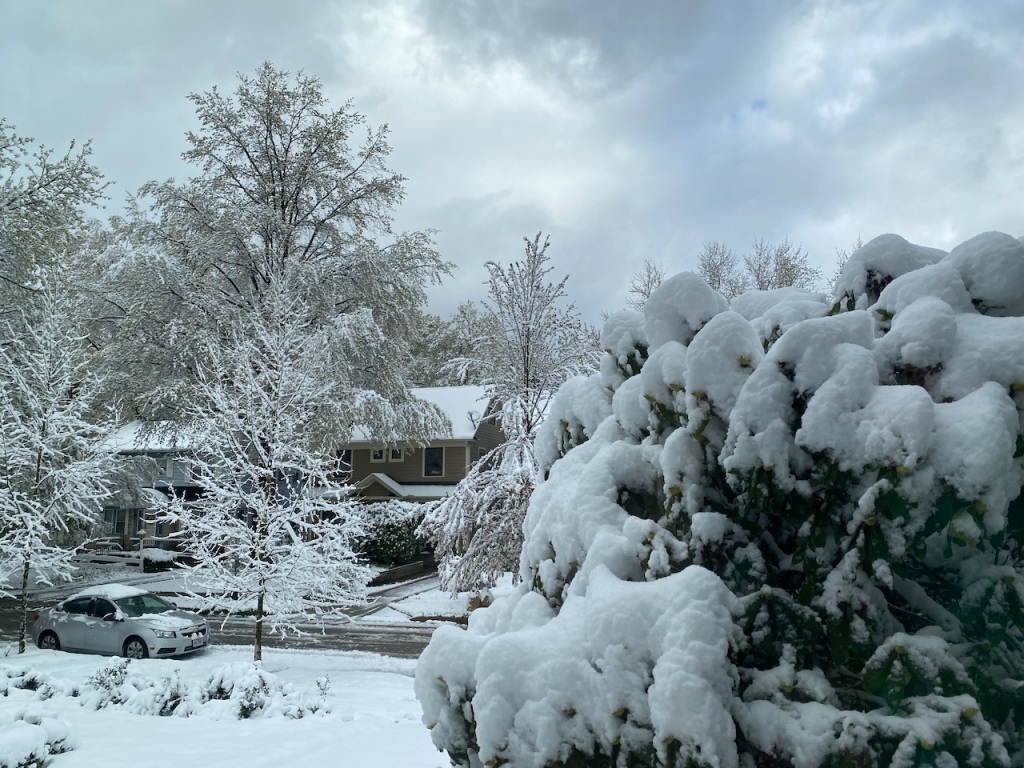
This is a recurring theme.
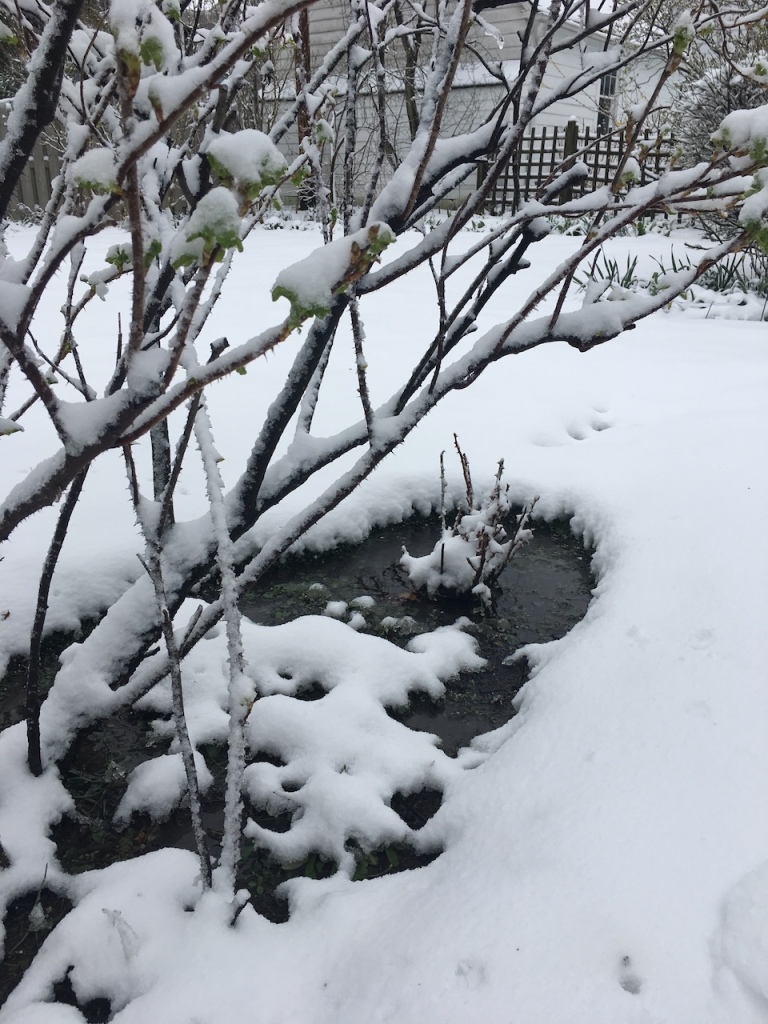
I could go on – I have lots of epic snow pictures from Aprils past. We got a full foot of snow one Easter. But April also brings daffodils, so not all hope is extinguished.

Given this sterling record of opaque skies and outright blizzards, many people traveled to Texas to see the eclipse. The climate statistics for clear skies there are better there than here, and indeed, better than most other places along the path of totality, making it the destination of choice for serious eclipse chasers. But weather is notoriously fickle: climate is what you expect; weather is what you get. The day of the eclipse it was cloudy in Texas. You make your bets and you roll the dice.
The Build Up
Here in Cleveland, the early clouds had cleared to a brilliant blue by noon. At this time there was a special lunch followed by a panel discussion that I served on, together with Prof. Paul Iverson, an expert on ancient culture and the Antikythera Mechanism, a remarkably advanced analog computer for accurately predicting planetary motions including eclipses, Prof. Aviva Rothman, an historian of the Scientific Revolution and Kepler in particular, and Prof. Chris Zorman, an engineer involved in conducting radio experiments on the reaction of the ionosphere to the passage of the moon’s shadow. I opened by describing what was happening physically, and closed with a description of what to expect to see. There were good questions form the audience; perhaps my favorite being if we could extend the eclipse experience by chasing it in a plane. Yes, but the shadow sweeps past at over a thousand miles per hour, so to keep up you’d have to go supersonic, so totality could only be extended for however long your fuel could last. Attendance was great but limited* to the largest ballroom in the Tinkham Veale University Center; I’m told it filled within minutes of registration being opened. Duh – I had been trying to impress the enormity of this event on the powers that be on campus for years without success. Most people seem incapable of thinking that far ahead. Still, they did eventually get on it, and did a good job organizing everything, albeit at a predictably desperate clip for the last few weeks. The campus event turned out well, if for a rather smaller audience than demand might have had it.

By design, the panel ended right as the partial eclipse started. Freiberger Field next door to Tinkham Veale had been designated for eclipse viewing, complete with portapotties and, bemusingly, a little fenced-off area$ for us VIPs who had been at the lunch. I preferred to watch it with my colleagues and students who had set up a small telescope with a projection screen nearby.
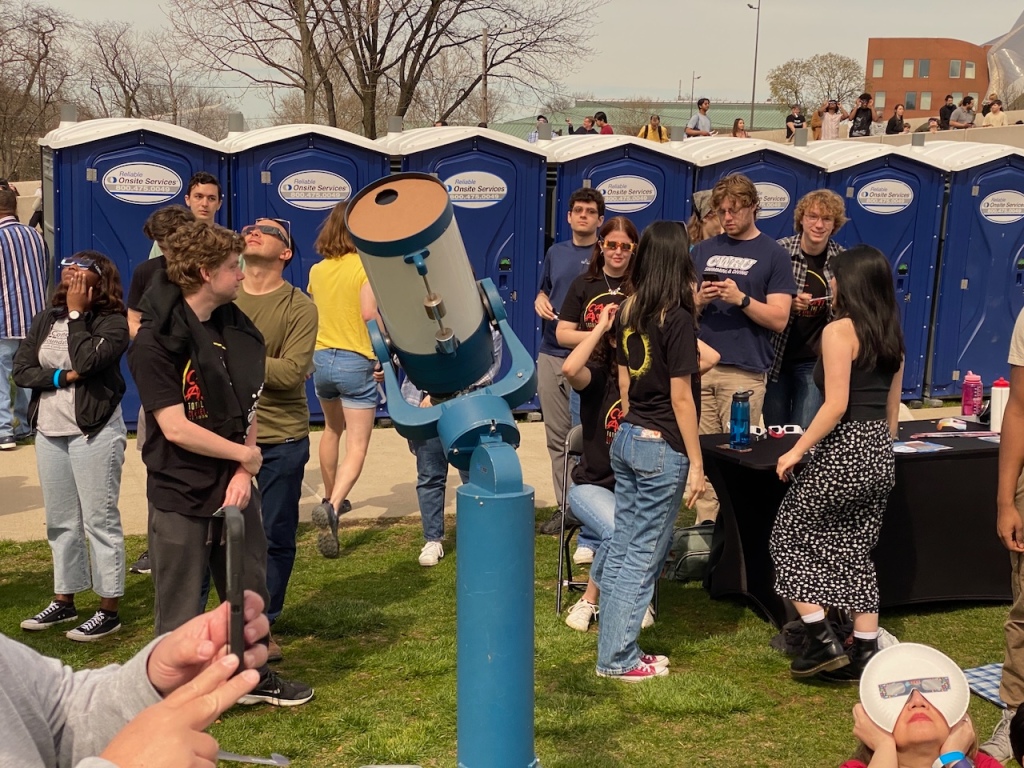
Many of our students are wearing the t-shirt I designed to commemorate the occasion.
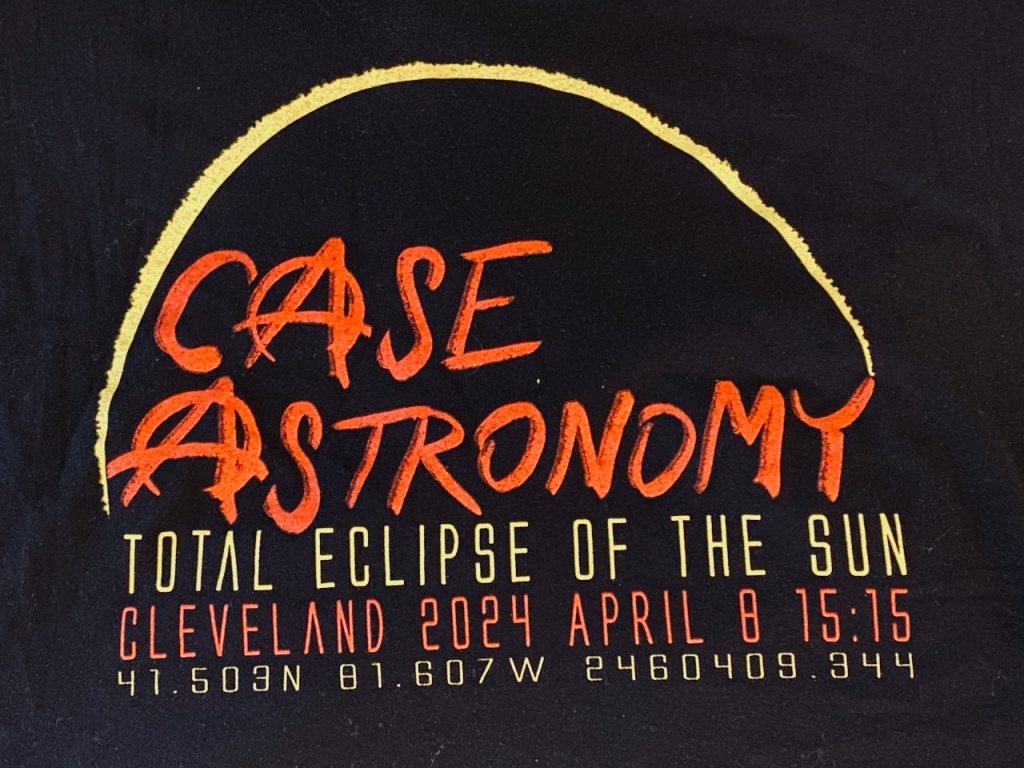
First, though, I walked back to my office to drop off the sports coat I had donned for the panel, as it had become downright warm in the sun. It would take a bit over an hour to reach totality, so I had plenty of time to walk across campus and back. It also gave me something to do besides mill about in anticipation: I looked up occasionally on the walk over, checking the progress of the moon through eclipse glasses; it was casually devouring the sun one bite at a time as I casually crossed campus.
I grabbed a bundle of eclipse glasses from my office. There were plenty at Freiberger, but we had started stocking up on them before that had been arranged, and what else were we going to use them for? As soon as I stepped outside, I encountered a couple of students who needed them. Immediately after that, a visitor from Pittsburgh who was originally form Armenia asked where he could get paper supplies to make a pinhole camera. I handed him a pair of eclipse glasses and pointed him towards the nearby FedEx, with directions on to the campus bookstore should that prove helpful. By this time, I could tell that the light was starting to dim.
On the way back, the weather worsened. Some murk started to roll in, and for a bit it looked like it might become completely opaque. But the clouds remained limited to cirrus clouds that amounted to only a thin veil, and which provided a rainbow halo completely encircling the sun. A few commercial jetliners left long, fat contrails+ whose shadows could be seen cast on the cirrus at lower elevation.

At this point, it started to cool off. One could viscerally feel the effect of the shade cast by the moon. The temperature dropped 7oF, then rebounded some afterwards. I did not regret having abandoned my jacket – it was still a pleasant spring day – but probably would have put it back on for a bit if I still had it with me. I could hear some mild grumbles in the crowd that they wanted one. You could definitely feel the difference as a mild breeze picked up.
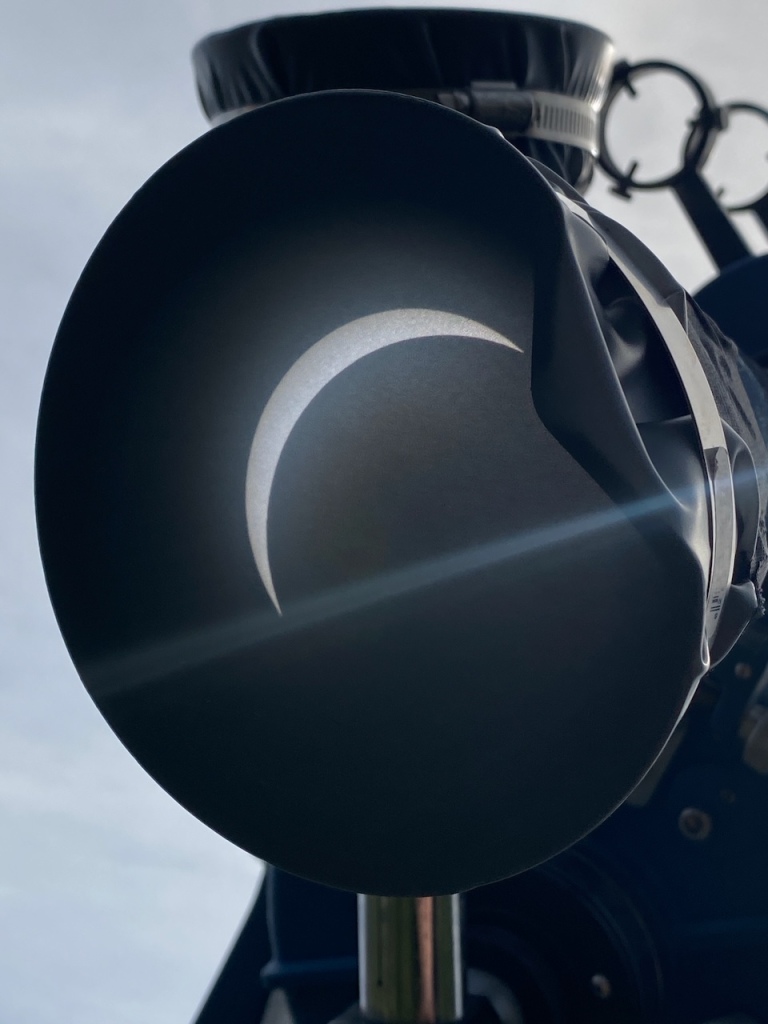
Partial Eclipses Past
Partial eclipses are just that: partial. In the 2014 my younger daughter and I went to the roof of a parking structure to watch one that reached about 30% coverage. And indeed, it looked like a clean bite had been taken out of the sun. But if you didn’t know when to look (and have appropriate eye protection), you wouldn’t notice. The sun was still plenty bright, and there was no perceptible change in the environment. Indeed, we noticed that people didn’t notice. We had come prepared with welder’s glass, and offered a glimpse to passers by. No one took us up on it. Indeed, every single one gave us a wide berth as obviously crazy people.
On 21 August 2017, there was a major eclipse for which the path of totality passed several hundred miles to our south. We saw about 80% coverage in Cleveland on that occasion. I figured that people who were serious about it would have left town to see it. However, there had been a lot of hype about this eclipse, so I expected that, come the day of, a lot of folks would be calling up us astronomers asking what’s up.
In anticipation, we (the CWRU Department of Astronomy) had stocked up on eclipse glasses. The day of, we sallied forth to entertain those who found a sudden interest in astronomical events. This included many people from both on and off campus, but especially new freshmen – it happened during Discovery Week, which is freshmen orientation here. On that occasion, I had difficult persuading the people running orientation that they needed to account for the eclipse in their scheduling. They were having none of it: they had a very busy schedule, it was important the the freshmen attend all orientation events, and if we wanted to host an astronomical event, we should schedule it sometime else. Eventually I had to appeal to the provost, pointing out that students would have heard of the eclipse, so were likely to walk out of whatever orientation event was running at the time, so it would be better to embrace the event than pretend it wasn’t happening. So we did.
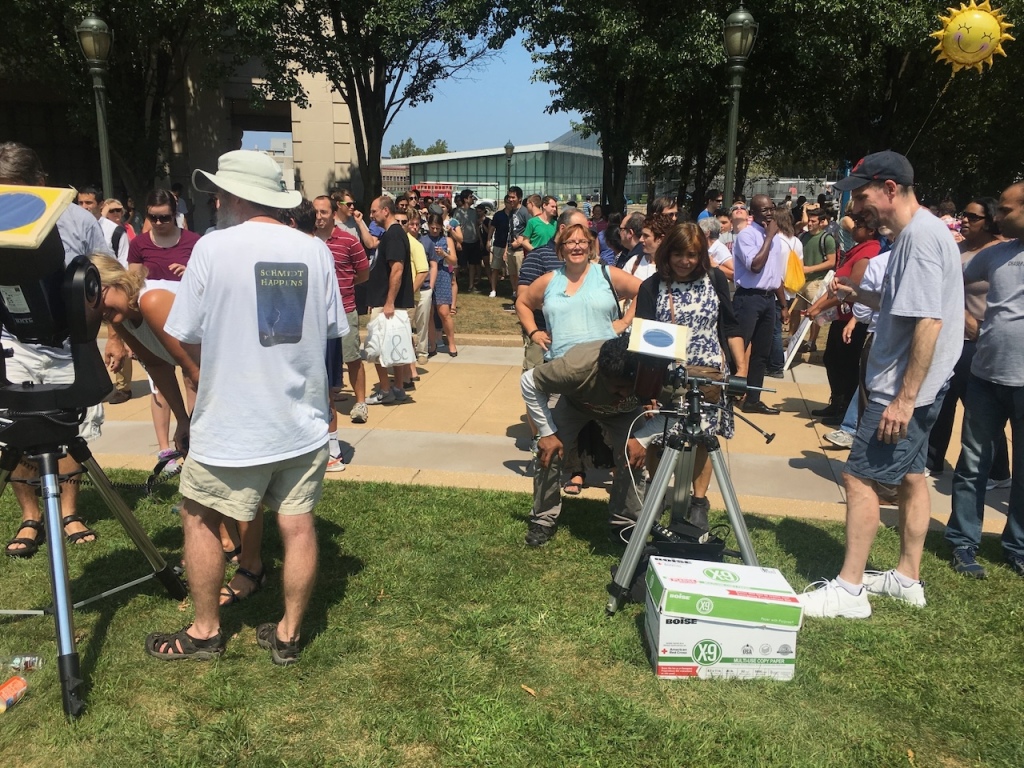
The weather in August 2017 was clear and hot. While my colleagues operated the telescopes, I ran around handing out eclipse glasses and playing carnival barker. This included announcing the time of maximum coverage, which this time was enough to cause a perceptible dimming. It was weird – it wasn’t like a cloud blocking the sun; indeed, the sky was completely clear. Everything just seemed… tuned down. Nature stilled. The light gave everything a sepia tone; sort of a golden hour from above rather than from the horizon.
At this point, anything with a small hole acted as a pinhole camera to project an image of the partial eclipse. A colander works quite well for this. Heck, even the leaves of the trees got into it.
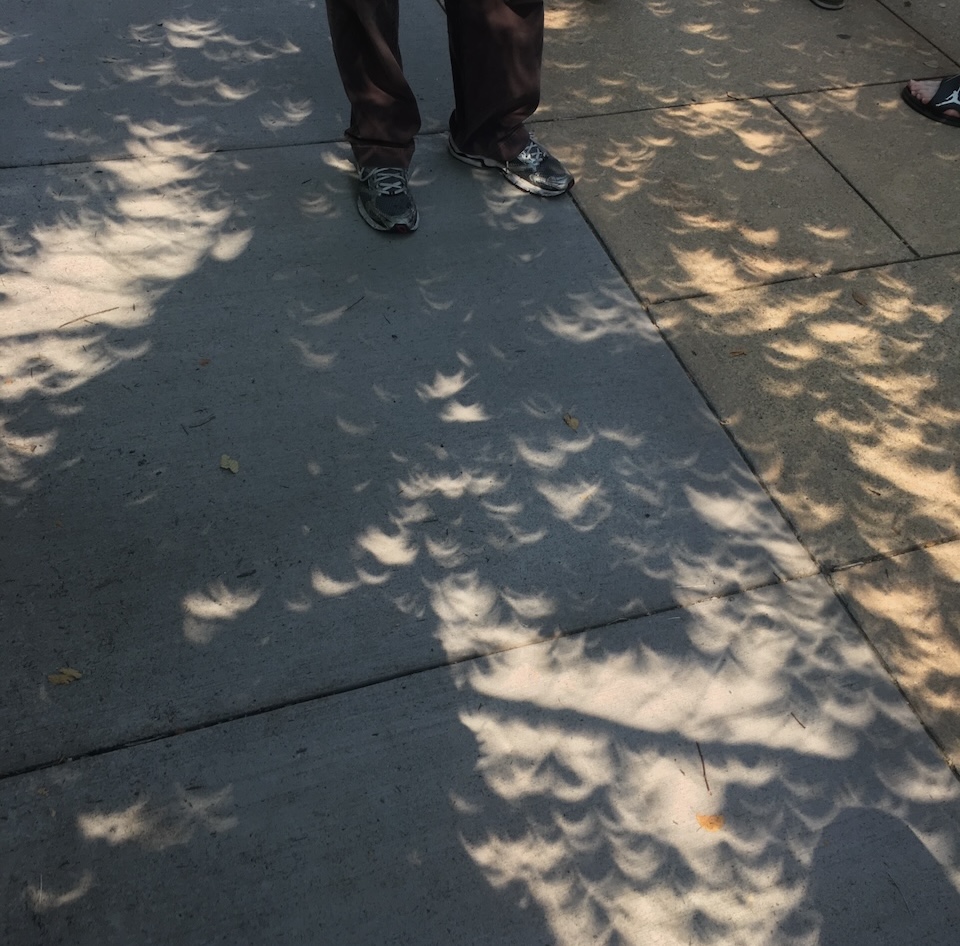
We were lucky with the weather. We were hot and dehydrated, but we got through it all. After we had packed up but before I could even walk back to the department, storm clouds gathered and the heavens opened with torrential rain: a classic summer thunderstorm. I was happy to wait it out in Tinkham Veale, quite exhausted. I realized then that we couldn’t pull off a similar event for a full eclipse, which would have exponentially more interest. The partial eclipse was all we could manage, and the department is half the size now that it was then#.
Totality Approaches
The light level at the maximum of the 2017 partial eclipse returns us to the 2024 eclipse. We had reached a point that was uncharted territory for me. With some help from a filter, the phone camera could now kinda sorta make out that something was happening.
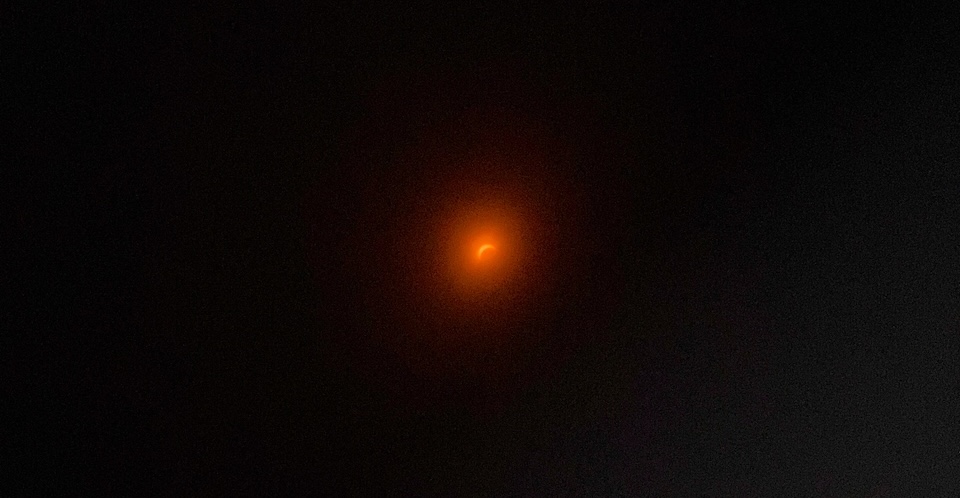
The light obtained the same weird, bright-yet-dim sepia tone I recalled from 2017. It continued to darken, and began to look like sunset on the horizon, only all 360o around. Then the umbral shadow swept in, the cirrus clouds above marking its path. We were in a giant dark shadow, with daylight perceptible at a distance all around us. But for us, it got dark.
I watched the last limb of the sun disappear behind the moon through the eclipse shades, the thin horns of light contracting rapidly. It broke into segments, atmospheric seeing warring with lunar topography. When I could see no more, I took them off just in time to see the diamond ring effect just as the sun disappeared entirely. The total eclipse had arrived.
Totality
I’m pretty jaded. I’ve worked at major observatories in Arizona and New Mexico, in the Chilean Andes, on La Palma in the Canary islands. I’ve traveled the world debating deep matters of cosmology and philosophy with renowned scientists from all over, each brilliant in their own way, some the most admirable people you could hope to meet; others, not so much. I’ve seen partial lunar eclipses, total lunar eclipses, the 2004 and 2012 transits^ of Venus, and partial solar eclipses. At this point, I’m very hard to impress. But I had never a total solar eclipse.
I was gobsmacked.
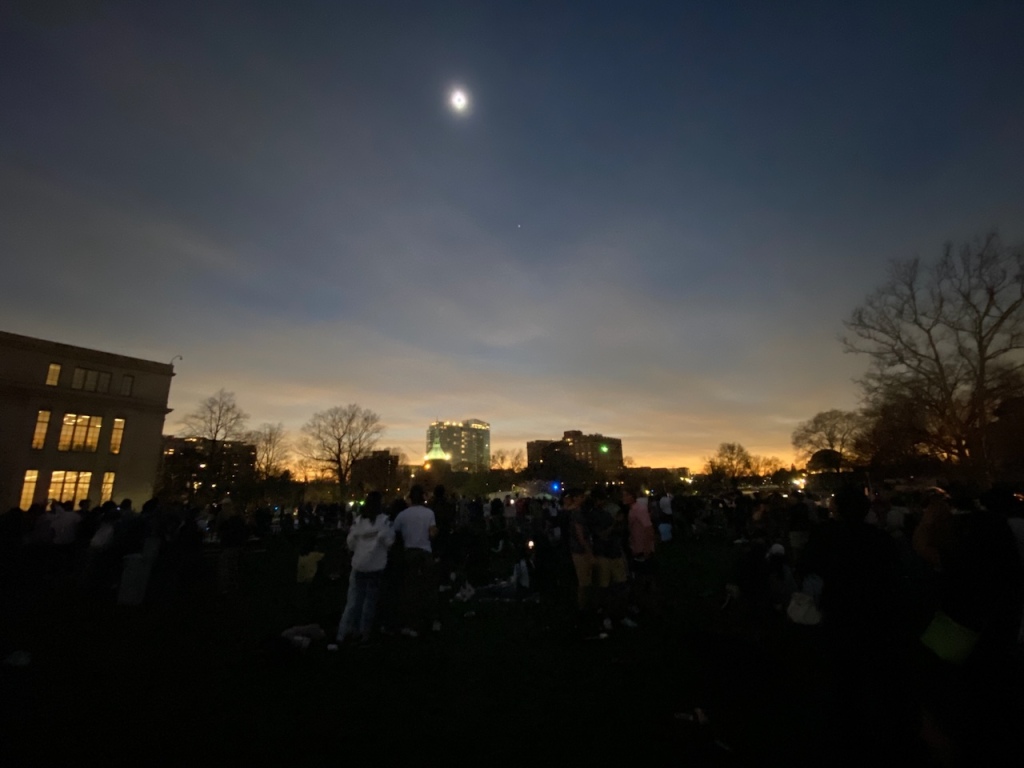
Words really can’t do justice to a full eclipse. Totality is just stunning. The disk of the moon completely covers the body of the sun, and lurks there for a few minutes. This natural occultation experiment reveals the solar corona. Always there but never otherwise seen, the corona shimmers like a phantasm of white silk around the dark circle of the moon; it is so mesmerizing you’d think it overdone if it were a special effect. I was enthused to make out the small, pink glow of a solar prominence near the bottom of the disk from our perspective: a band of plasma entrained in the magnetic field of sunspots like cosmic iron filings that glow in the pinkish Balmer line of hydrogen. Venus and Jupiter were easily visible; some folks saw Saturn as well. Saturn was over towards the horizon; I didn’t look that far aside for 3 minutes and 49 seconds. Pictures really don’t do it justice. They seem ill-suited to illustrate the extend of the corona without overexposing the prominences.
You literally had to see it to appreciate it.
Fade Out
People cheered as totality started, and again as it came to an end. Daylight returned, albeit the weird dim sepia light of the partial eclipse. What had seemed stunning in its own right a few short minutes before now seemed almost mundane. We talked and milled about and shared a general sense of well-being stemming from bearing common witness to a remarkable event that is both phenomenally rare and stunningly beautiful, a shared feeling that reminds me of Melville’s words:
Oh! my dear fellow beings, why should we longer cherish any social acerbities, or know the slightest ill-humor or envy!
Melville, in Moby Dick
As the light trended back to normal, we decided to pay a visit to the rooftop telescope, where Bill and Charley had watched the eclipse. We were joined by roving groups of astronomy students and alumni, and found Charley in the dome of the 9″ with a projector in place, the brass of the eyepiece warm to the touch.
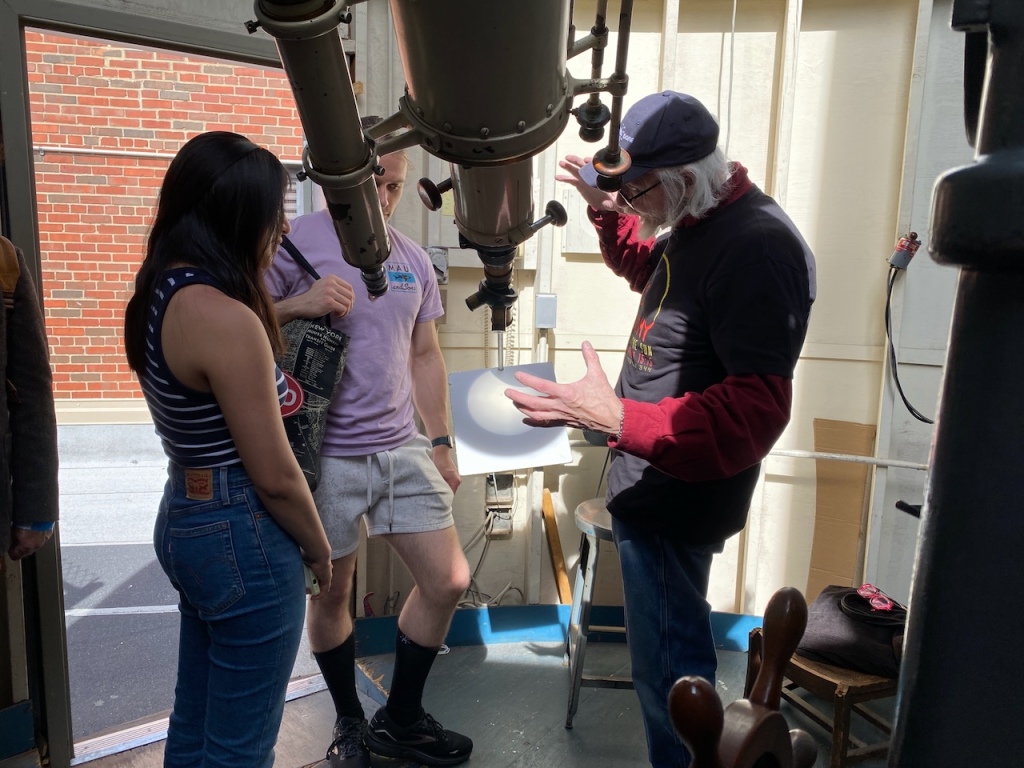
There was a communal feeling of satisfaction and general well-being that I can describe no better than totality itself. Classes had been cancelled for the day, and rightly so – nothing could be more educational, nothing could match this experience, and there was no going back inside afterwards.
As the moon passed away, one could see sunspots in the projection from the 9″. That was true during the 2017 partial eclipse as well; I share an image from that time as it shows the sunspots most clearly:
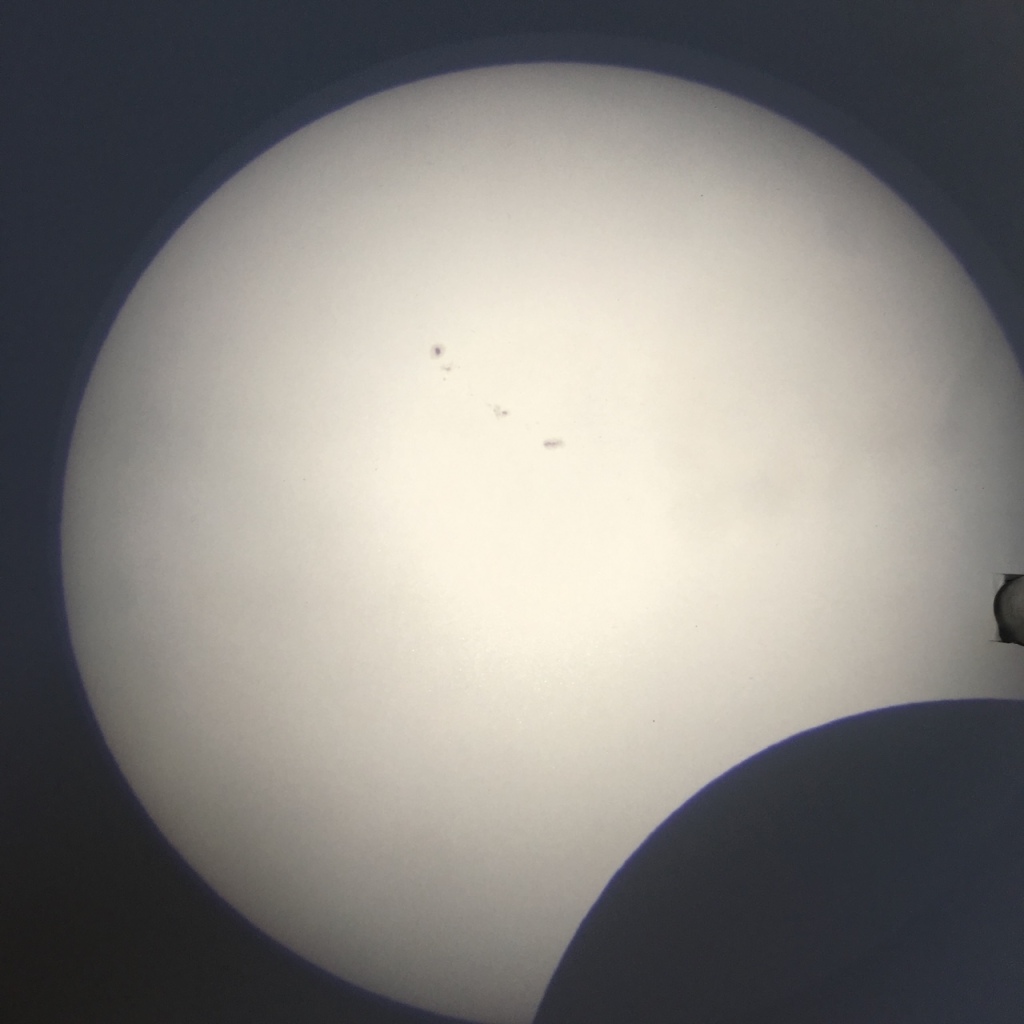
For perspective, recall the spectacular coincidences that make eclipse observations possible. The sun is vastly larger than the moon, but also farther away. Yet they appear very nearly the same angular size in the sky, with the greater distance to the sun relative to the moon almost exactly right to balance the greater size of the sun relative to the moon. It didn’t have to be that way. Indeed, it seems phenomenally unlikely that it should be so. That it is so makes total eclipses extraordinarily rare, as the point of the conical shadow of the moon only just reaches the surface of the earth, so only a small spot is in eclipse at a given time. Indeed, the slight eccentricity of the moon’s orbit means that sometimes the point of the umbra doesn’t even reach the surface, and we get an annular eclipse in which the sun is mostly but not quite fully covered. We were lucky to get nearly four minutes of totality, but the small size of the shadow cast by the moon on the Earth by itself guarantees that eclipses are rare. Add in that the moon’s orbit is tipped about 5 degrees to the plane of the ecliptic (the orbit of the Earth around the sun) and that none of the relevant periods (day, lunar month, year) are integer multiples of one another means that the perfect alignment (syzygy) required for an eclipse rarely repeats over the same spot. But it does happen, and we humans noticed it – by the time of the ancient Babylonians, the lengthy periods on which eclipses were likely to repeat were known – they lacked sufficiently accurate data to predict exactly when and where an eclipse would occur, but they knew when it was eclipse season – a sort of astronomical weather forecast: scattered clouds with a chance of eclipses. These events made a big impression on us; it would have taken careful observations conveyed over many generations to work this out.
Eclipses on planet Earth are quite remarkable. We could have had a bigger moon or a smaller moon or lots of moons or no moon at all. But we got a moon that is exactly the right size at exactly the right distance to almost exactly cover the disk of the sun, and reveal to the human eye the corona that is otherwise lost in the glare of the solar photosphere. This coincidence in space is remarkable enough, but it is also a coincidence in time. The moon helps raise the tides on the Earth, and the tides pull back against the moon. The net effect is a slow transfer of angular momentum from the spin of the Earth to the orbit of the moon. As a consequence, the moon is slowly getting farther away (a few cm/year) and the length of the day is gradually getting longer, having been about 22 hours a mere 600 million years ago, around the time of the Cambrian explosion when multicellular life proliferated. Consequently, the moon would have been a bit closer and appeared somewhat larger on the sky for early land animals; dinosaurs would have seen somewhat more frequent eclipses of longer duration, but would have had a worse view of the corona and prominences, as the larger moon would have blocked more of the emission from near the surface of the sun.
The coincidences that make our current eclipse experience are rather special in both time and space. Make of that what you will.
*There had been so many preparatory emails that the precise location of the discussion panel was lost in the hectic babble. I remembered it was in Tinkham Veale, which is big, but not so big that I was worried about finding the right room. That would surely be easier than finding it in the enormous email thread. When I arrived, I figured the most likely location was the ballroom on the second floor, and indeed, I found the stairs blocked by a sign 2ND FLOOR CLOSED FOR PRIVATE EVENT. Bypassing this, I was greeted by enhanced campus security and a person who asked my name. Scrolling a handheld device, she got that concerned look officious people get when you’re not on the list. She politely checked the spelling of my name, checked again, then apologized that I wasn’t on the list. As this was going on, I realized this must be a list for people who registered to hear the panel, so I said “I’m the astronomer ON the panel.” Her eyes got big. “Oh!” she said. “Come right in…”
So, the moral of that story is that you can always talk your way into an exclusive event by claiming to be an astronomer – provided, of course, that it is a very specialized subset of exclusive events about astronomy.
$I found it bemusing because it was just a tiny picket fence set up in the midst of a much larger field. There was nothing special or meritorious about the location, so it was just exclusionary, which is a thing I’m generally against.
+Contrails like this are usually a bad sign for observational astronomy, being a harbinger of bad seeing as well as high humidity. In this case, it was just part of the show – and a very small part at that. Mostly I pitied the fools who had paid to confine themselves inside a metal tube at 10 km altitude while the most amazing of celestial events was going on.
#In 2017, the academic staff of the Department of Astronomy consisted of five faculty and one research scientist. By 2019 attrition had reduced us to three faculty. That no hires have been made since then is a long story of administrative incompetence and malfeasance.
^I almost missed the 2004 transit, which was conveniently observable in Europe but which we nearly over by the time the sun rose in the U.S. Not only did one have to get up at the literal crack of daen, but that meant the sun was on the eastern horizon. The only way I could find to witness it was to hold a pair of binoculars at a window in our attic and project the image onto the wall.
The 2012 transit was more friendly to observers in North America, occurring mid-day. I set up a small telescope in front of my house; the neighbors took turns holding the projection screen for all to see. Many stayed for hours to follow the gradual progress of Venus against the face of the sun.
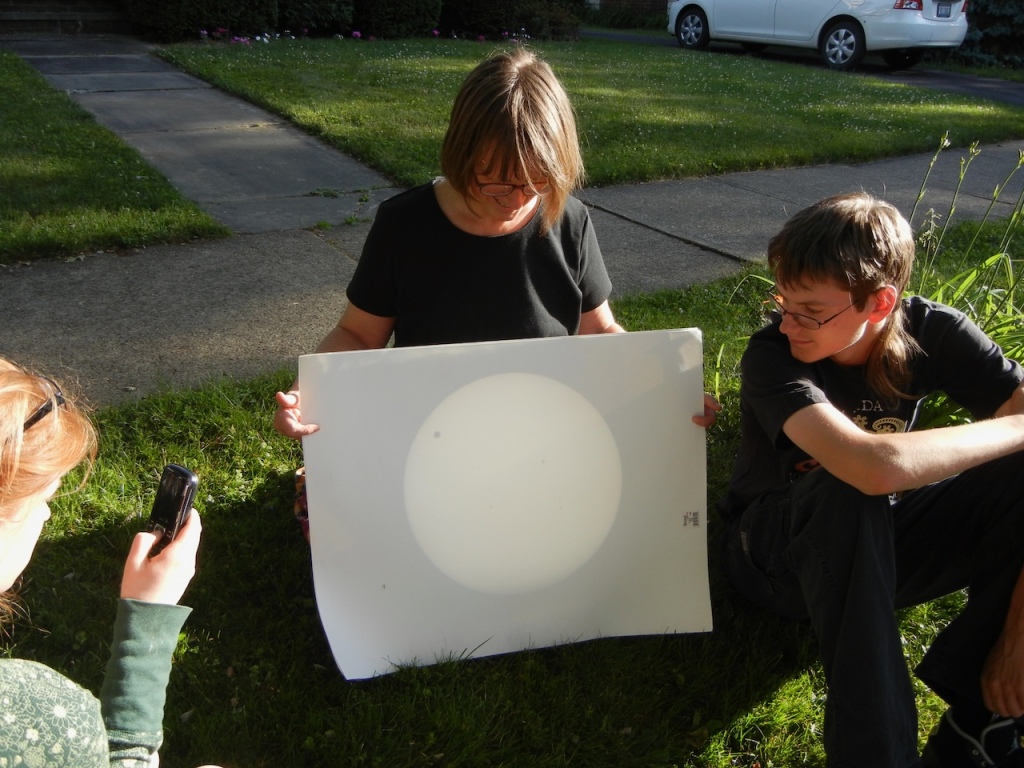
I hope you caught one of these transits yourself. The next one is in December 2117.
Total solar eclipses can be addictive. Now you have seen one and appreciated that the conditions were less than ideal, you may feel impelled to go eclipse-chasing. There is another good solar eclipse coming up, visible from Africa and the southern tip of Spain on August 2nd 2027.
https://eclipse.gsfc.nasa.gov/SEplot/SEplot2001/SE2027Aug02T.GIF
This is one of the longest eclipses, reaching 6m 22s near Luxor in Egypt but over 4 minutes even at the southern tip of Spain.
LikeLike
Yes, I can see the attraction. I’m not likely to become an eclipse chaser, but if I can arrange to be at the right place at the right time, I will certainly be inclined to do so.
LikeLike
By the way, I disagree with the depiction of the conditions being less than ideal. Did I say that? I did not. I certainly said there was good reason to expect that we could get clouded out, but we did not. We did have some light cirrus. This did not appreciably impact visibility, and in fact enhanced the experience by providing a layer in the atmosphere in which the shadow could be seen approaching.
LikeLike
Even light cirrus will have tended to smooth out the structure of the corona, but I’m not surprised you didn’t notice this. Did you see shadow bands?
LikeLike
No, no shadow bands that I noticed.
LikeLike
A very nice summary of a special event!
Regarding the chasing the eclipse in a supersonic flight: it has been done (at least once) and for scientific reasons: https://www.nature.com/articles/246072a0. They experienced 74min of totality, in a carefully planned flight path (and timing). And they used a modified prototype Concorde 001 (https://en.wikipedia.org/wiki/Concorde_aircraft_histories).
LikeLike
Cool. I did not know the Concorde had been employed in this fashion. Good to know it could be done with something besides an SR-71 Blackbird!
LikeLike
I watched a Youtube video where the creator plotted light plane traffic across the US (you can find it by searching “Eclipse 2024 was almost a disaster”). Lower altitude aircraft were orange, higher altitude green. At the time of totality, light aircraft formed a green line along the path of totality (11:56 in the video), then quickly dispersed afterwards. Hopefully they also were looking out for other planes.
The video creator ended up in Montreal for the totality and was blessed with clear skies. As for me, I was in Toronto right on the edge of totality. I went outside during totality with my solar glasses, but the sky was cloudy all day. I did get a couple of shots of the cloudy sky, and I did see everything get darker and feel the temperature drop for about 2 minutes, then it got bright again. That was about it.
I may try to travel to a future total eclipse (right now eyeing Australia in July 2028), but Mother Nature is fickle, there is never a guarantee of good weather (hence the aircraft option).
I’m really happy for those who were able to witness this incredible astronomic phenomenon first hand. It is also heartening to see that a seasoned astrophysicist has not lost his sense of wonder (“it … was … awesome!”). So much science and mythology surrounding eclipses. The fact that the sun and moon are almost identical in size in the earth’s sky still amazes me.
We really need to keep looking up and whenever possible and witness the night sky the way our ancestors did whenever we can (even if we have to travel far from city lights).
The universe … is … awesome!
LikeLike
arXiv:2404.06538 (astro-ph)[Submitted on 9 Apr 2024]
Refracted Gravity Solutions from Small to Large Scales
https://doi.org/10.48550/arXiv.2404.06538
“Matsakos and Diaferio [ 45 ] proposed in 2016 a different approach. They formulatedrefracted gravity (RG), a classical modified theory of gravity which does not assume thepresence of DM and is regulated by the value of the local mass density ρ, rather than of theacceleration a. The Poisson equation of RG is modified at first member by the presence ofthe gravitational permittivity, ϵ(ρ), a monotonic increasing function of ρ which boosts thegravitational field in regions where the density goes below a critical value, reproducing theeffect of DM in Newtonian gravity. “
opinion of replacing ao with local mass density ρ,
LikeLike
One can swap in a surface density for an acceleration since a = G*S. But a 3D density is not the same, so can be excluded. It really has to be an acceleration scale; this has been shown empirically many times.
LikeLike
the authors also included ” gravitational permittivity, ϵ(ρ)” and “a monotonic increasing function of ρ which boosts thegravitational field in regions where the density goes below a critical value” so it’s the similar to an acceleration scale
aren’t low density similar to an acceleration scale
their claim also offers a new ways to get galaxies clusters to
LikeLike
*surface* density is similar to an accelerations scale. The 3D density adds another dimension, so no, they’re not really the same.
maybe there is more to it than this; there would have to be for it to be relevant.
LikeLike
are there any gravity theories that succeeds with surface density
are there any theoretical advantages to surface density over an accelerations scale, for example galaxies clusters
could surface density interact with the cosmology constant and reproduce ao
LikeLike
It is conceivable that the problem is related to the cosmological constant; e.g., with inertial mass depending on the acceleration wrt everything else in a Machian sense, perhaps mediated by the Unruh radiation experienced when accelerated through the vacuum.
LikeLike
could you express opinion on
Anomalous contribution to galactic rotation curves due to stochastic spacetime
Jonathan Oppenheim, Andrea Russo
Subjects: General Relativity and Quantum Cosmology (gr-qc); Astrophysics of Galaxies (astro-ph.GA); High Energy Physics – Theory (hep-th)
https://arxiv.org/pdf/2402.19459.pdf
“….Here, we show that this stochastic behaviour leads to a modification of general relativity at low accelerations.
In the low acceleration regime, the variance in the acceleration produced by the gravitational field is high in comparison to that produced by the Newtonian potential, and acts as an entropic force, causing a deviation from Einstein’s theory of general relativity….We compute how this modifies the expectation value of the metric via the path integral formalism, and find that an entropic force driven by a stochastic cosmological constant can explain galactic rotation curves without needing to evoke dark matter. “
LikeLike
To avoid any confusion, RG is nothing to do with the refractive medium gravity theory that was mentioned on an earlier thread, and has a different mechanism. Planck scale gravity (PSG, Kerr, March 2023) has the mechanism helical path refraction, in a hybrid theory where all masses emit a very small scale refractive medium. It dissipates in the radial direction, and explains the close link Stacy showed between the discrepancy and the visible matter, via the RAR. It explains it because the medium is emitted consistently depending on mass and mass distribution.
At larger scales an excess builds up, which is the collisionless material known to be in clusters due to lensing data from collisions. The unexplained planes of satellite galaxies problem is caused by a disk of the emitted medium building up.
The near-proof from PSG, which the other day I looked at what it actually near-proves, shows that all masses emit a medium. As they’re looking for DM, it may be relevant.
An equation in which one substitutes into Snell’s law with terms from PSG, gives:
[penultimate equation here] summary_PDF | gwwsdk1
which leads to [last equation there]
With that equation one can pick any two points on any orbit through any spherical field, it can even be the path of a falling object released one meter from the ground. Put gravity numbers in for the speeds at those two radii, the two sides of the equation will agree to around 16 decimal places, showing that Snell’s law is at work, therefore refraction is at work. Any comments would be appreciated – it clearly could have bearing on the mass discrepancy.
LikeLike
Btw, I should have said, if you couldn’t make sense of the angle to the normal, nor could I. It seemed unnecessary to go into it in the summary, but in PSG (as matter is disturbances in the dimensions, the orientation of which can vary) there are small-scale local angles as well as large-scale ones.
The equation was found when testing the theory for an object falling vertically – everything is as expected, the helical path is as in other parts of the theory, the normal is a radial line in the field. It was then found to work for all orbits and trajectories, not only radial ones. I can’t say I understood it at first, but I have a better understanding of it now.
It isn’t necessary to go into this to find that the system works, and for a very large range of situations and gravity fields. But if you want a near-proof that refraction is at work without any complications, so it’s more of a new and startling fact, just use it for radial paths.
LikeLike
The Oppenheimer & Russo paper on “Anomalous contribution to galactic rotation curves due to stochastic spacetime” is discussed by Sabine Hossenfelder in her blog for 12-Mar-2024, some way under
https://backreaction.blogspot.com/search?q=+oppenheim
LikeLike
The reason a physical mechanism with a conceptual picture is needed, rather than the mathematical tweaks people are searching through, is that we have a bunch of conceptual clues. They cover quite a range – enough for hybrid theories to have been getting more attention. Some of the clues are addressed in outline in a post above, such as the planes of satellite galaxies problem – but whether it’s that picture or another, it’s going to be something of that kind. (But that picture has a near proof attached, which helps.) Having a good conceptual picture, even in comparatively rough and ready form, is like putting a large electromagnet next to the haystack.
LikeLike
Sorry to have to post a clarification, but I can’t leave what I said about one thing as vague as that. When looking on radial paths, I found what I was looking for, almost like confirming a prediction. It was then found to apply more widely – this had advantages and distadvantages, as I only understood that aspect later. There’s a clarification about it in a paper I’m preparing on the background theory, which led to both DQM and PSG:
In the method for testing PSG[16], expressions from PSG are substituted into Snell’s law, and refraction is shown to be likely to be at work in gravity. A complication relating to the angle with the normal should be explained: because matter is disturbances in the dimensions (the orientation of which can vary), there are local small-scale angles as well as large-scale ones. But when matter is on radial paths in the field, the small-scale angle is the same as the large-scale one: in either, the angle to the normal is a radial line, and for ‘unrolled’ helical path, arccos (v/c). Early experimentation with this involved objects falling on radial paths, but it was later found to work with all orbits and trajectories.
If matter on a radial path is used, the result is absolutely clear, without complication. So although equation 7 in ref.[16] works for any two random points on any orbit through any spherical field, what it shows is best conveyed via examples with objects on radial paths.
When matter is on other paths, the normal from the small-scale angle is still radial, due to the nature of the PSG field. This is shown because in other situations in PSG, matter is found to be rotating on horizontal circular paths in the field. This includes two situations examined in the PSG paper: an object thrown upwards to pause before falling back (in standard refraction, a laser in a graded medium does the same, and reaches a ‘turnover point’), and an object held in the field before being released[16]. The geometry shows a local frame is created by the field, in which matter behaves as if the cylinders are radial, and takes horizontal circular paths. In PSG reference frames imply relational positionings for the dimensions.
LikeLike